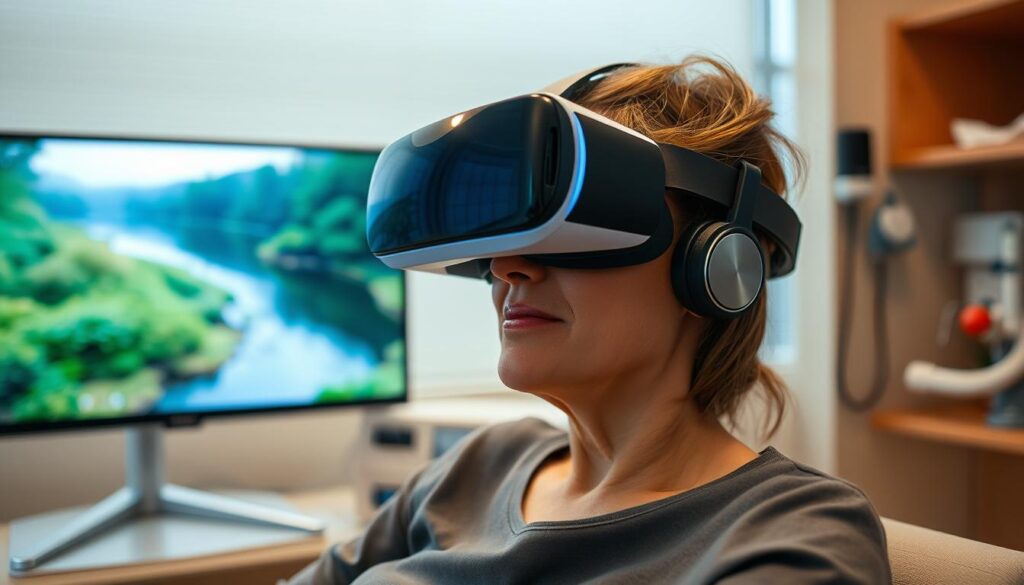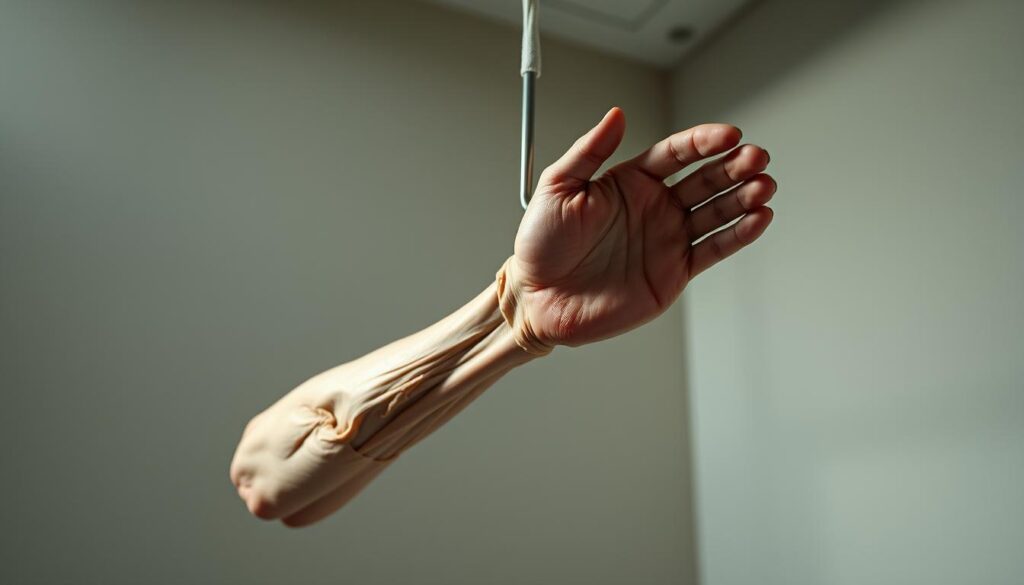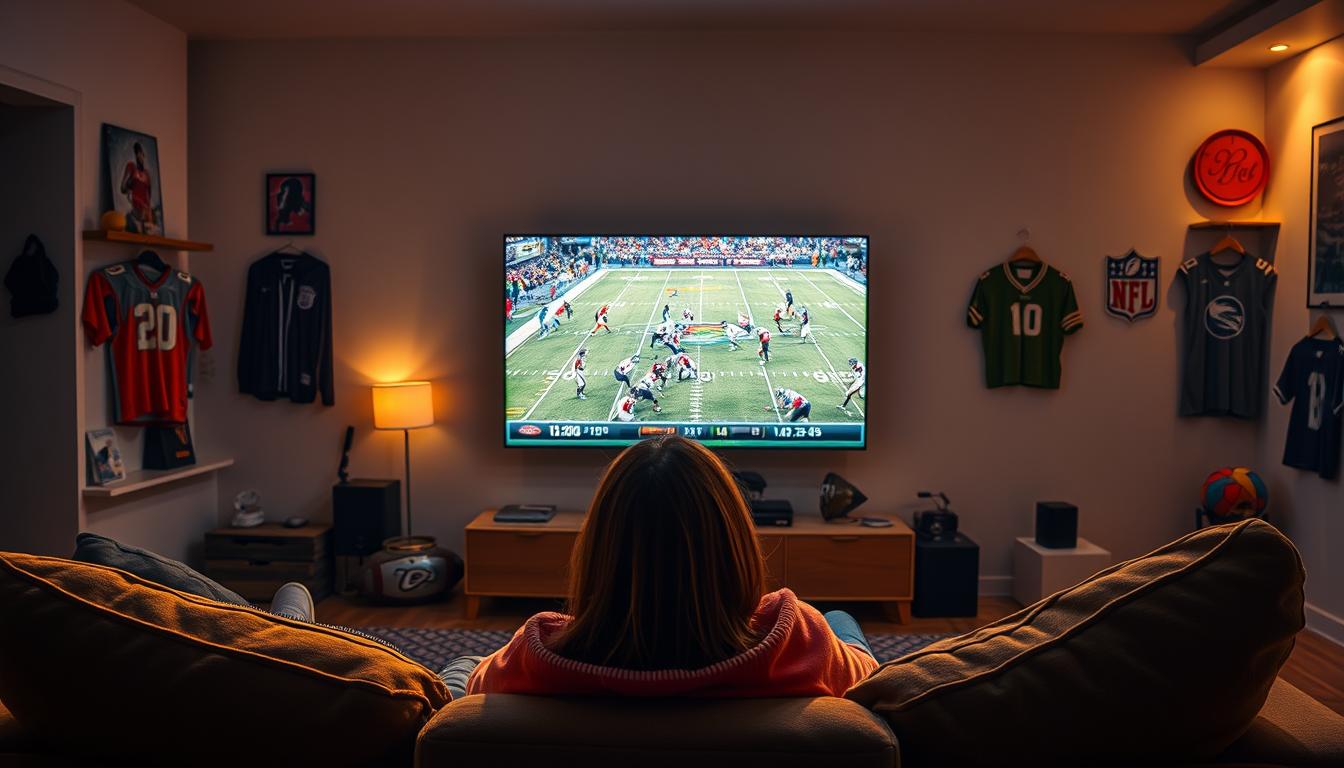Anúncios
Have you ever wondered how virtual reality can change recovery for those with muscle weakness after being stuck in one place?
VR games for muscle recovery have become popular in rehab. New tech like the Apple Vision Pro and HTC Vive Pro makes therapy more personal. It makes recovery fun and effective, helping patients regain strength and move better.
Anúncios
Introduction to Virtual Reality in Rehabilitation
Virtual reality is changing how therapists help patients with musculoskeletal injuries. It uses immersive therapy to create virtual worlds that mimic real-life activities. Patients practice important movements in these virtual spaces, helping them recover.
VR systems are very flexible, making therapy more engaging. Doctors can adjust the virtual experiences to meet each patient’s needs. This makes therapy sessions both fun and effective, helping patients stick to their recovery plans.
Studies show that immersive therapy boosts both physical and mental recovery. It helps patients overcome anxiety or frustration that might slow them down. So, virtual reality is a powerful tool in helping people regain their strength and move better.
Anúncios

Understanding Immobilization and Its Effects on Muscle Recovery
Immobilization can harm the body’s health, causing muscle loss. When joints and muscles don’t move for a long time, it’s hard to get back to normal. This makes it tough to move well again, which is a big challenge in getting better.
People who have had orthopedic trauma face many hurdles. Pain is a big one, making it hard to move. This pain can also make them feel scared to try to get better, which is called kinesiophobia.
To fight the bad effects of not moving, starting to move again early is key. This helps prevent muscle loss and gets the range of motion back faster. A good recovery plan should tackle all these issues, helping patients get better faster.

The Benefits of Using VR Games for Muscle Recovery After Immobilization
Virtual reality (VR) is changing how we do rehabilitation. It offers new ways to make recovery better. Two big pluses of VR games in rehab are better engagement and feedback in real-time. These help create a great space for getting better.
Improved Engagement and Motivation
VR games make rehab fun, keeping patients excited to do their exercises. They enjoy the interactive and immersive parts of the games. This makes them want to do their therapy, which is key for muscle recovery after being stuck in one place.
Real-time Feedback and Progress Tracking
VR also tracks how well patients are doing in real-time. They can see how they’re improving right away, which helps them stay on track. Doctors can use this info to make therapy plans that fit each person’s needs better. This makes recovery more effective by matching therapy to each patient’s unique situation.
| Aspect | Impact on Rehabilitation |
|---|---|
| Engagement | Increases patient participation in exercises, leading to better muscle recovery. |
| Motivation | Promotes a positive attitude towards recovery, reducing feelings of frustration. |
| Real-time Feedback | Enables immediate understanding of progress, bolstering commitment to the program. |
| Biomechanical Data | Guides personalized rehabilitation plans, enhancing treatment effectiveness. |
Types of VR Games Effective in Rehabilitation
Virtual reality (VR) offers a variety of experiences for rehabilitation. These games engage patients in new ways, helping with movement and recovery. There are two main types: simulation-based games and interactive fitness games. Each has its own benefits for therapy.
Simulation-based Games
Simulation-based games put players in real-like settings. They practice daily tasks in a safe space. This helps improve how well patients move and coordinate.
By doing tasks that feel like real life, these games boost confidence. They make patients feel more ready to do everyday activities again. The fun nature of these games also keeps patients motivated, making therapy more effective.
Interactive Fitness Games
Interactive fitness games mix fun and competition into therapy. They make patients want to move more by making it fun. This mix of play and exercise is key for recovery.
These games use gamification to keep patients interested. They make therapy enjoyable and challenging. This makes patients more likely to stick with their therapy plan.
| Type of Game | Focus Area | Benefits |
|---|---|---|
| Simulation-based Games | Mobility & Coordination | Realistic practice, confidence building |
| Interactive Fitness Games | Physical Engagement | Enhanced motivation, enjoyable recovery |
VR Games for Muscle Recovery After Immobilization
Virtual reality is changing how we recover from being stuck in one place. It lets us make rehab plans that fit each person’s needs. This makes therapy more effective and personal.
Customization for Individual Needs
VR therapy makes rehab plans special for each person. It takes into account their age, injury, and how they move. This ensures exercises match their abilities.
Targeted Exercises for Specific Injuries
VR also helps focus on specific injuries. It lets doctors create rehab plans that really help. Patients can see their progress, which motivates them more.
| Factor | Traditional Rehabilitation | Personalized VR Therapy |
|---|---|---|
| Customization | Standardized approaches | Tailored to individual needs |
| Engagement | Passive participation | Active involvement through immersive experiences |
| Feedback | Delayed evaluations | Real-time feedback and adjustments |
| Goal Alignment | General recovery goals | Specific goals based on injuries |
How to Choose the Right VR System for Rehabilitation
Choosing the right VR system for rehabilitation is important. You need to think about what the patient needs. VR technology has grown, with devices like the Apple Vision Pro and HTC Vive Pro offering different features.
The Apple Vision Pro is great for tracking joint movements, which is key for rehab exercises. The HTC Vive Pro is better for room-scale activities, allowing for more movement.
Consider how easy the system is to use and how comfortable it is. The cost also matters, as it affects how many places can use it. Make sure the system works with what you already have. Each system tracks data differently, which can affect how well it works for rehab.
Here’s a look at two popular VR systems:
| Feature | Apple Vision Pro | HTC Vive Pro |
|---|---|---|
| Joint Movement Tracking | High precision | Moderate precision |
| Room-Scale Capability | Limited | Excellent |
| Usability for Patients | User-friendly interface | Requires some training |
| Cost | Higher price point | Moderate pricing |
| Data Analysis Features | Advanced analytics | Basic analytics |
Doctors should know what each system can do. This helps make sure it fits with the patient’s rehab goals. This way, VR can be more effective in helping patients.
Integrating VR Games into Rehabilitation Programs
Using VR in rehab programs is a new way to help patients get better. It’s important to have clear goals for these programs. VR games make therapy fun and help track how well patients are doing.
Setting Goals and Monitoring Progress
Having clear goals is key for good rehab. VR helps set up interactive goals that fit each patient’s needs. It lets therapists see how well patients are doing and adjust treatment plans as needed.
Combining VR with Traditional Therapeutic Techniques
Using VR with traditional therapy makes rehab better. It combines hands-on therapy with fun VR games. This mix helps patients stay motivated and do better in their recovery.
Case Studies and Success Stories
VR rehabilitation case studies show how virtual reality helps muscles recover after being still for a long time. A group of patients after surgery used VR therapy to get their movement back. They found their flexibility and strength improved a lot.
This shows VR can change how we do rehabilitation.
Another success story is with stroke patients. VR therapy made them more interested in their exercises. They could do things with less pain. Many said they could do daily tasks on their own again.
This shows VR is a new and good way to help patients recover.
| Case Study | Patient Group | Key Improvements |
|---|---|---|
| Post-Surgery Rehabilitation | Orthopedic Patients | Increased Range of Motion, Strength Recovery |
| Stroke Recovery | Neurological Patients | Lower Pain Levels, Improved Functional Abilities |
These VR studies show big progress in patient recovery. They also show VR is becoming more accepted in medicine. As more success stories come, using VR in rehab looks very promising.
Challenges and Limitations of VR in Rehabilitation
Using virtual reality in rehab comes with its own set of problems. These issues affect how easy it is to use and how well it works. Knowing these challenges helps doctors and therapists find ways to improve care.
Technical Issues and Accessibility
VR needs special equipment, which can be a problem in many places. This is especially true when money is tight. Some patients can’t get the help they need because of this.
Also, problems with software and updates can make it hard for everyone to use VR. This can cause frustration for both doctors and patients.
Patient Compliance and Learning Curve
Getting patients to stick with VR can be tough. Some people might feel sick or uncomfortable while using it. This can make them not want to keep using it.
Learning to use VR can also be hard. This can make patients feel frustrated and less likely to keep going. But, with the right training and slow introduction, these problems can be solved. This helps create a better space for healing.
Future Directions for VR in Muscle Recovery
The future of VR in muscle recovery looks bright. New technologies are coming along, promising to change how we recover muscles. One big step is adding artificial intelligence to VR systems. This will make rehab programs adjust in real-time to how well a patient is doing.
This could make rehab more fun and keep exercises right for each person. It’s a big step forward.
Another exciting area is using VR in telehealth. This means people can get top-notch rehab therapy from home. It opens up rehab to more people, no matter where they live.
But, we need more research to make sure VR works well for a long time. Studies will help make these new tools better. They’ll make sure VR fits well with what we already know works in rehab.
Conclusion
VR games for muscle recovery are changing the game in rehabilitation. They use immersive tech to help patients recover faster. This tech makes rehab more fun and interactive, which boosts motivation and progress tracking.
Even though there are still hurdles like tech problems and patient buy-in, VR’s benefits are clear. It lets doctors create custom recovery plans for each patient. This teamwork between experts and tech creators will lead to better recovery results.
VR is set to change rehab for the better. It will make recovery faster and more enjoyable. The future of rehab looks bright, thanks to VR games.
FAQ
What is the role of virtual reality (VR) in rehabilitation?
Virtual reality is a new tool for rehab, especially in orthopedics. It makes therapy more engaging and helps patients stick to their plans. It also lets doctors create treatments that fit each patient’s injury.
How does immobilization affect muscle recovery?
Being still too long can weaken muscles and stiffen joints. It can also lead to fear of moving, making rehab harder. Moving early can help avoid these problems.
What are the key benefits of using VR games in rehabilitation?
VR games make rehab fun and track progress in real time. They also let doctors tailor programs to meet each patient’s needs.
What types of VR games are effective in rehabilitation?
Good VR games include ones that mimic daily tasks and games that make fitness fun. These games motivate patients and help them recover.
How is VR therapy customized for individual rehabilitation needs?
VR therapy is made just for each patient. It considers their age, injury, and how mobile they are. This way, exercises are more effective and safe.
What should I consider when choosing a VR system for rehabilitation?
Look at how easy it is to use, the cost, and what technology it needs. Also, check if it works with your rehab plans for the best results.
How can VR games be integrated into existing rehabilitation programs?
To add VR games to rehab, set clear goals and use the games to track progress. This way, they support traditional therapy for a complete rehab plan.
Are there real-world success stories of VR in rehabilitation?
Yes, many studies show VR helps patients move better, feel less pain, and recover faster after being still for a long time.
What challenges are associated with implementing VR in rehabilitation?
Using VR in rehab can face technical issues and problems with patients getting sick from VR. Also, teaching patients how to use VR is key for success.
What does the future hold for VR in muscle recovery?
VR in rehab is set to get even better. Future updates might include AI for adjusting programs and using VR over the internet. This could make top-notch rehab more accessible.




